Sony KD-65A1, KD-55A1 User Manual

Television
4-693-658-11(1)
|
|
|
|
|
|
|
|
Reference Guide |
GB |
|
|
|
|
|
|
|
|
|
|
|
|
|
|
|
|
|
|
|
|
|
|
|
|
|
|
|
|
|
|
|
Guide de référence |
FR |
|
|
|
|
|
|
|
|
|
|
|
|
|
|
|
|
|
|
|
|
|
|
|
|
|
|
|
|
|
|
|
Guía de referencia |
ES |
|
|
|
|
|
|
|
|
|
|
|
|
|
|
|
|
|
|
|
|
|
|
|
|
|
|
|
|
|
|
|
Referentiegids |
NL |
|
|
|
|
|
|
|
|
|
|
|
|
|
|
|
|
|
|
|
|
|
|
|
|
|
|
|
|
|
|
|
Referenzanleitung |
DE |
|
|
|
|
|
|
|
|
|
|
|
|
|
|
|
|
|
|
|
|
|
|
|
|
|
|
|
|
|
|
|
Guia de referência |
PT |
|
|
|
|
|
|
|
|
|
|
|
|
|
|
|
|
|
|
|
|
|
|
|
|
|
|
|
|
|
|
|
Guida di riferimento |
IT |
|
|
|
|
|
|
|
|
|
|
|
|
|
|
|
|
|
|
|
|
|
|
|
|
|
|
|
|
|
|
|
Referensmaterial |
SE |
|
|
|
|
|
|
|
|
|
|
|
|
|
|
|
|
|
|
|
|
|
|
|
|
|
|
|
|
|
|
|
Referencevejledning |
DK |
|
|
|
|
|
|
|
|
|
|
|
|
|
|
|
|
|
|
|
|
|
|
|
|
|
|
|
|
|
|
|
Viiteopas |
FI |
|
|
|
|
|
|
|
|
|
|
|
|
|
|
|
|
|
|
|
|
|
|
|
|
|
|
|
|
|
|
|
Referanseveiledning |
NO |
|
|
|
|
|
|
|
|
|
|
|
|
|
|
|
|
|
|
|
|
|
|
|
|
|
|
|
|
|
|
|
Przewodnik |
PL |
|
|
|
|
|
|
|
|
|
|
|
|
|
|
|
|
|
|
|
|
|
|
|
|
|
|
|
|
|
|
|
Referenční příručka |
CZ |
|
|
|
|
|
|
|
|
|
|
|
|
|
|
|
|
|
|
|
|
|
|
|
|
|
|
|
|
|
|
|
Referenčná príručka |
SK |
|
|
|
|
|
|
|
|
|
|
|
|
|
|
|
|
|
|
|
|
|
|
|
|
|
|
|
|
|
|
|
Felhasználói útmutató |
|
HU |
|
|
|
|
|
|
|
||||
|
|
|
|
|
|
|
|
|
|
|
|
|
|
|
|
|
|
|
|
|
|
|
|
|
|
|
|
|
|
Ghid de referinţă |
RO |
|
|
|
|
|
|
|
|
|
|
|
|
|
|
|
|
|
|
|
|
|
|
|
|
|
|
|
|
|
|
|
|
|
|
|
|
|
|
|
|
|
|
Информация за продукта |
BG |
|
|
|
|
|
|
|
|
|
|||
|
|
|
|
|
|
|
|
|
|
|
|
|
|
|
|
|
|
|
|
|
|
|
|
|
|
|
|
|
|
Οδηγός αναφοράς |
GR |
|
|
|
|
|
|
|
|
|
|
|
|
|
|
|
|
|
|
|
|
|
|
|
|
|
|
|
|
|
|
|
Başvuru Kılavuzu |
TR |
|
|
|
|
|
|
|
|
|
|
|
|
|
|
|
|
|
|
|
|
|
|
|
KD-65A1 / 55A1
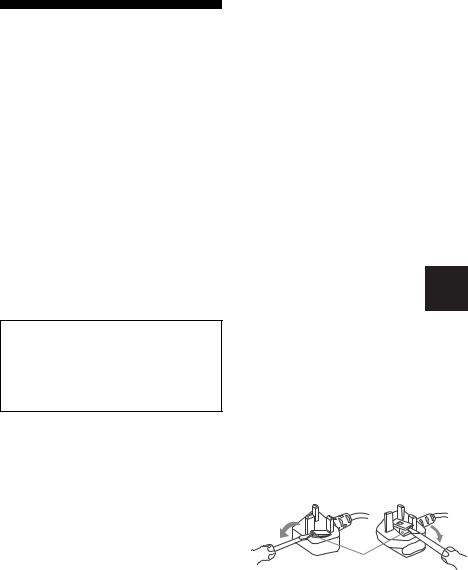
Table of Contents
IMPORTANT NOTICE . . . . . . . . . . . . . . . . . . . . 3
Safety Information . . . . . . . . . . . . . . . . . . . . . 3
Precautions . . . . . . . . . . . . . . . . . . . . . . . . . . . 5
Protecting the TV Screen (OLED TV) . . . . . . .6
Parts and Controls . . . . . . . . . . . . . . . . . . . 7
Controls and Indicators . . . . . . . . . . . . . . . . . 7
Using Remote Control . . . . . . . . . . . . . . . . 8
Remote Control Parts Description. . . . . . . . .8
Connection Diagram . . . . . . . . . . . . . . . . 10 Installing the TV to the Wall . . . . . . . . . . 12
Using the optional Wall-Mount Bracket . . . 12
Troubleshooting . . . . . . . . . . . . . . . . . . . . 17
Troubles and Solutions. . . . . . . . . . . . . . . . . 17
Specifications . . . . . . . . . . . . . . . . . . . . . . 18
Internet Connection and Data Privacy
This product connects to the internet during initial setup as soon as a network is connected in order to confirm internet connection, and later to configure the Home screen. Your IP address is used in these and all other internet connections. If you do not want your IP address be used at all, do not set-up the wireless internet function and do not connect an internet cable. Please refer to the privacy information presented in the set-up screens for further details of internet connections.
Introduction
Thank you for choosing this Sony product.
Before operating the TV, please read this manual thoroughly and retain it for future reference.
Note
•Before operating the TV, please read the “Safety Information” (page 3).
•Images and illustrations used in the Setup Guide and this manual are for reference only and may differ from the actual product.
Location of the Setup Guide
Setup Guide is placed on top of the cushion inside the TV carton.
Help/Help Guide
Help feature offers a lot of information about your TV. To use the Help feature, press HELP on the remote control. You can find how to and troubleshooting from the list or keyword search. Select [Help Guide] on Help menu to view the manual. If you connect your TV to the internet, the Help feature and information will be updated.
Location of the identification label
Labels for the TV Model No., Production Date (year/month) and Power Supply rating are located on the rear of the TV or package. They can be found by removing the center cover.
WARNING
TO PREVENT THE SPREAD OF FIRE, KEEP
CANDLES OR OTHER OPEN FLAMES AWAY FROM THIS PRODUCT AT ALL TIMES.
NOTICE FOR CUSTOMERS IN THE UNITED KINGDOM
A moulded plug complying with BS1363 is fitted to this equipment for your safety and convenience.
Should the fuse in the plug supplied need to be replaced with the same rating of fuse approved by ASTA or BSI to BS 1362 (i.e., marked with  or
or  ) must be used.
) must be used.
If the plug supplied with this equipment has a detachable fuse cover, be sure to attach the fuse cover after you change the fuse. Never use the plug without the fuse cover. If you should lose the fuse cover, please contact your nearest Sony service station.
FUSE
How to replace the fuse
Open the fuse compartment with a blade screwdriver, and replace the fuse.
Please refer to the illustration that actually equipped with the product.
2GB

IMPORTANT NOTICE
This product has been manufactured by or on behalf of Sony Corporation, 1-7-1 Konan Minato-ku Tokyo, 108-0075 Japan. Inquiries related to product compliance based on European Union legislation shall be addressed to the authorized representative, Sony Belgium, bijkantoor van Sony Europe Limited, Da Vincilaan 7-D1, 1935 Zaventem, Belgium. For any service or guarantee matters, please refer to the addresses provided in the separate service or guarantee documents.
Notice for Radio Equipment
Hereby, Sony Corporation declares that the radio equipment types KD-65A1,
KD-55A1 are in compliance with the
essential requirements and other relevant provisions of Directive 1999/5/EC. For details, please access the following URL: http://www.compliance.sony.de/
This radio equipment can be operated in the EU without infringing applicable requirements on the use of radio spectrum.
Notice for customers: the following information is only applicable to equipment sold in countries applying EU directives.
TV wireless system may be operated in following countries:
AT, BE, HR, CY, CZ, DK, EE, FI, FR, DE, EL, HU, IE, IT, LV, LT, LU, MT, NL, PL, PT, SK, SI, ES, SE, UK, IS, LI, NO, CH, BG, RO, TR, AL, BA, MK, MD, RS, ME, Kosovo
This equipment can be operated in other non-European countries.
Safety Information
WARNING
Batteries must not be exposed to excessive heat such as sunshine, fire or the like.
Never place a television set in an unstable location. A television set may fall, causing serious personal injury or death. Many injuries, particularly to children, can be avoided by taking simple precautions such as:
Using cabinets or stands recommended by the manufacturer of the television set.
Only using furniture that can safely support the television set.
Ensuring the television set is not overhanging the edge of the supporting furniture.
Not placing the television set on tall furniture (for example, cupboards or bookcases) without anchoring both the furniture and the television set to a suitable support.
Not placing the television set on cloth or other materials that may be located between the television set and supporting furniture.
Educating children about the dangers of climbing on furniture to reach the television set or its controls.
If your existing television set is being retained and relocated, the same considerations as above should be applied.
Installation/Set-up
Sufficient expertise is required when installing the TV to the Table-Top Stand.
Refer to the Setup Guide supplied with the TV for stand installation.
Sony is not liable for any damage or injury caused by mishandling or improper installation.
Install and use the TV set in accordance with the instructions below in order to avoid any risk of fire, electric shock or damage and/or injuries.
Installation
•The TV set should be installed near an easily accessible mains socket.
•Place the TV set on a stable, level surface to prevent it from falling over and causing personal injury or property damage.
•Install the TV where it cannot be pulled, pushed, or knocked over.
•Install the TV so that the TV bottom does not protrude out from
the TV stand (not supplied). If the TV bottom protrudes out from |
|
the TV stand, it may cause TV set to topple over, fall down, and |
GB |
cause personal injury or damage to the TV. |
•Only qualified service personnel should carry out wall-mount installations.
•For safety reasons, it is strongly recommended that you use
Sony accessories, including:
Wall-Mount Bracket SU-WL450
•Be sure to use the screws supplied with the Wall-Mount Bracket when attaching the Wall-Mount Bracket to the TV set. The supplied screws are designed as indicated by illustration when measured from the attaching surface of the Wall-Mount Bracket. The diameter and length of the screws differ depending on the Wall-Mount Bracket model.
Use of screws other than those supplied may result in internal damage to the TV set or cause it to fall, etc.
10 mm - 14 mm
 Screw (M6)
Screw (M6)
Wall-Mount Bracket
TV’s rear cover
Transporting
•Before transporting the TV set, disconnect all cables.
•Two or three people are needed to transport a large TV set.
•When transporting the TV set by hand, hold it as shown below. Do not put stress on the panel and the frame around the screen.
•When handling or mounting the TV set, do not lay down the TV.
3GB
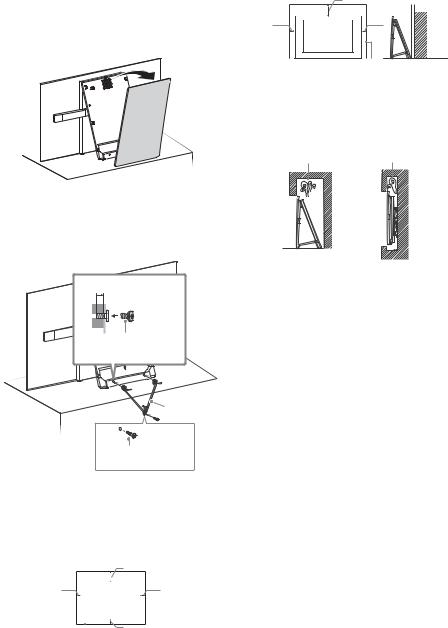
•When transporting the TV set, do not subject it to jolts or excessive vibration.
•When transporting the TV set for repairs or when moving, pack it using the original carton and packing material.
Topple prevention
1 Remove the center cover.
2 Secure the TV to the TV stand.
10 mm - 14 mm
M6 screw (not supplied)
Cord (not |
supplied) |
Screw (not supplied)
Ventilation
•Never cover the ventilation holes or insert anything in the cabinet.
•Leave space around the TV set as shown below.
•It is strongly recommended that you use a Sony Wall-Mount Bracket in order to provide adequate air circulation.
Installed on the wall
|
|
|
|
30 cm |
||
10 cm |
|
|
|
|
|
10 cm |
|
|
|
|
|
|
|
|
|
|
|
|
|
|
|
|
|
|
10 cm |
||
|
|
|
|
|||
Leave at least this space around the set. |
||||||
Installed with stand
30 cm

 1 cm
1 cm
10 cm |
|
|
|
10 cm |
|
|
|
Wall
Leave at least this space around the set.
•To ensure proper ventilation and prevent the collection of dirt or dust:
Do not lay the TV set flat, install upside down, backwards, or sideways.
Do not place the TV set on a shelf, rug, bed or in a closet.
Do not cover the TV set with a cloth, such as curtains, or items such as newspapers, etc.
Do not install the TV set as shown below.
Air circulation is blocked.
Wall |
Wall |
Mains lead
Handle the mains lead and socket as follows in order to avoid any risk of fire, electric shock or damage and/or injuries:
Use only mains leads supplied by Sony, not other suppliers.
Insert the plug fully into the mains socket.
Operate the TV set on a 220 V - 240 V AC supply only.
When wiring cables, be sure to unplug the mains lead for your safety and take care not to catch your feet on the cables.
Disconnect the mains lead from the mains socket before working on or moving the TV set.
Keep the mains lead away from heat sources.
Unplug the mains plug and clean it regularly. If the plug is covered with dust and it picks up moisture, its insulation may deteriorate, which could result in a fire.
Note
•Do not use the supplied mains lead on any other equipment.
•Do not pinch, bend, or twist the mains lead excessively. The core conductors may be exposed or broken.
•Do not modify the mains lead.
•Do not put anything heavy on the mains lead.
•Do not pull on the mains lead itself when disconnecting the mains lead.
•Do not connect too many appliances to the same mains socket.
•Do not use a poor fitting mains socket.
Prohibited Usage
Do not install/use the TV set in locations, environments or situations such as those listed below, or the TV set may malfunction and cause a fire, electric shock, damage and/or injuries.
Locations:
•Outdoors (in direct sunlight), at the seashore, on a ship or other vessel, inside a vehicle, in medical institutions, unstable locations, near water, rain, moisture or smoke.
Environments:
•Places that are hot, humid, or excessively dusty; where insects may enter; where it might be exposed to mechanical vibration, near flammable objects (candles, etc.). The TV set shall not be exposed to dripping or splashing and no objects filled with liquids, such as vases, shall be placed on the TV.
4GB
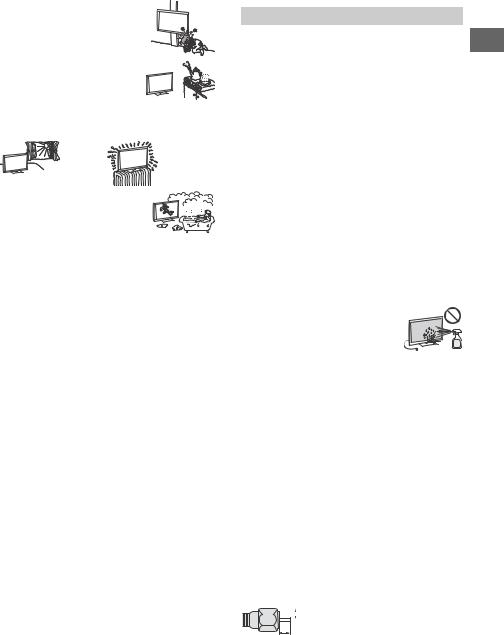
Situations:
•Use when your hands are wet, with the cabinet removed, or with attachments not recommended by the manufacturer. Disconnect the TV set from mains socket and aerial during lightning storms.
•Install the TV so that it sticks out into an
open space. Injury or damage from a person or object bumping into the TV may result.
• Place the TV in a humid or dusty space, or in a room with oily smoke or steam (near cooking tables or humidifiers). Fire, electric shock, or warping may result.
•Install the TV in places subject to
extreme temperature such as in direct sunlight, near a radiator or a heating vent. The TV may overheat in such condition which can cause deformation of the enclosure and/or TV malfunction.
• If the TV is placed in the changing room of a public bath or hot spring, the TV may be damaged by airborne sulfur, etc.
•For best picture quality, do not expose the screen to direct illumination or sunlight.
•Avoid moving the TV from a cold area to a warm area. Sudden room temperature changes may cause moisture condensation. This may cause the TV to show poor picture and/or poor colour. Should this occur, allow moisture to evaporate completely before powering the TV on.
Broken pieces:
•Do not throw anything at the TV set. The screen glass may break by the impact and cause serious injury.
•If the surface of the TV set cracks, do not touch it until you have unplugged the mains lead. Otherwise this may cause an electric shock.
When not in use
•If you will not be using the TV set for several days, the TV set should be disconnected from the mains for environmental and safety reasons.
•As the TV set is not disconnected from the mains when the TV set is just turned off, pull the plug from the mains to disconnect the TV set completely.
•Some TV sets may have features that require the TV set to be left in standby to work correctly.
For children
•Do not allow children to climb on the TV set.
•Keep small accessories out of the reach of children, so that they are not mistakenly swallowed.
If the following problems occur...
Turn off the TV set and unplug the mains lead immediately if any of the following problems occur.
Ask your dealer or Sony service centre to have it checked by qualified service personnel.
When:
Mains lead is damaged.
Poor fitting of mains socket.
TV set is damaged by being dropped, hit or having something thrown at it.
Any liquid or solid object falls through openings in the cabinet.
About TV Temperature
When the TV is used for an extended period, the panel surrounds become warm. You may feel hot when touching there by the hand.
Precautions |
|
Viewing the TV |
GB |
|
•View the TV in moderate light, as viewing the TV in poor light or during long period of time, strains your eyes.
•When using headphones, adjust the volume so as to avoid excessive levels, as hearing damage may result.
OLED Screen
•Although the OLED screen is made with high-precision technology and 99.99 % or more of the pixels are effective, black dots may appear or bright points of light (white, red, blue, or green) may appear constantly on the OLED screen. This is a structural property of the OLED screen and is not a malfunction.
•Do not push or scratch the front filter, or place objects on top of this TV set. The image may be uneven or the OLED screen may be damaged.
•The screen and cabinet get warm when this TV set is in use. This is not a malfunction.
•When disposing of your TV be sure to follow your local laws and regulations.
Handling and cleaning the screen surface/ cabinet of the TV set
Be sure to unplug the mains lead connected to the TV set from mains socket before cleaning.
To avoid material degradation or screen coating degradation, observe the following precautions.
•To remove dust from the screen surface/cabinet, wipe gently with a soft cloth. If dust is persistent, wipe with a soft cloth slightly moistened with a diluted mild detergent solution.
•Never spray water or detergent directly on the TV set. It may drip to the bottom of the
screen or exterior parts and enter the TV set, and may cause damage to the TV set.
•Never use any type of abrasive pad, alkaline/acid cleaner, scouring powder, or
volatile solvent, such as alcohol, benzene, thinner or insecticide. Using such materials or maintaining prolonged contact with rubber or vinyl materials may result in damage to the screen surface and cabinet material.
•Do not touch the TV if your hand is covered in any chemical substance such as hand cream or sunblock.
•Periodic vacuuming of the ventilation openings is recommended to ensure to proper ventilation.
•When adjusting the angle of the TV set, move it slowly so as to prevent the TV set from moving or slipping off from its table stand.
Optional Equipment
•Keep optional components or any equipment emitting electromagnetic radiation away from the TV set. Otherwise picture distortion and/or noisy sound may occur.
•This equipment has been tested and found to comply with the limits set out in the EMC Directive using a connection signal cable shorter than 3 meters.
•This equipment has been tested and found to comply with the limits set out in the EMC Directive using a RF cable shorter than 30 meters for terrestrial/satellite/CATV terminal.
Recommendation of F-type plug
Projection of the inner wire from the connection part must be less than 1.5 mm.

 7 mm max.
7 mm max.
1.5 mm max.
(Reference drawing of the F-type plug)
5GB

Wireless Function of the unit
•Do not operate this unit near medical equipment (pacemaker, etc.), as this may result in the malfunction of the medical equipment.
•Although this unit transmits/receives scrambled signals, be careful of unauthorised interception. We cannot be responsible for any trouble as a result.
•This equipment should be installed and operated keeping a separation distance of 20 cm or more between the antenna of this device and a person's body.
Caution about handling the remote control
•Observe the correct polarity when inserting batteries.
•Do not use different types of batteries together or mix old and new batteries.
•Dispose of batteries in an environmentally friendly way. Certain regions may regulate the disposal of batteries. Please consult your local authority.
•Handle the remote control with care. Do not drop or step on it, or spill liquid of any kind onto it.
•Do not place the remote control in a location near a heat source, a place subject to direct sunlight, or a damp room.
Disposal of the TV set
Disposal of Old Electrical & Electronic Equipment (Applicable in the European Union and other European countries with separate collection systems)
This symbol on the product or on its packaging indicates that this product shall not be treated as household waste. Instead it shall be handed
over to the applicable collection point for the recycling of electrical and electronic equipment. By ensuring this product is disposed of correctly, you will help prevent potential negative consequences for the environment and human health, which could otherwise be caused by inappropriate waste handling of this product. The recycling of materials will help to conserve natural resources. For more detailed information about recycling of this product, please contact your local Civic Office, your household waste disposal service or the shop where you purchased the product.
Disposal of waste batteries (applicable in the European Union and other European countries with separate collection systems)
This symbol on the battery or on the packaging indicates that the battery provided with this
product shall not be treated as household waste. On certain batteries this symbol might be used in combination with a chemical symbol. The chemical symbols for mercury (Hg) or lead (Pb) are added if the battery contains more than 0.0005 % mercury or 0.004 % lead. By ensuring these batteries are disposed of correctly, you will help prevent potentially negative consequences for the environment and human health which could otherwise be caused by inappropriate waste handling of the battery. The recycling of the materials will help to conserve natural resources. In case of products that for safety, performance or data integrity reasons require a permanent connection with an incorporated battery, this battery should be replaced by qualified service staff only. To ensure that the battery will be treated properly, hand over the product at end-of-life to the applicable collection point for the recycling of electrical and electronic equipment. For all other batteries, please view the section on how to remove the battery from the product safely. Hand the battery over to the applicable collection point for the recycling of waste batteries. For more detailed information about recycling of this product or battery, please contact your local Civic Office, your household waste disposal service or the shop where you purchased the product.
Protecting the TV Screen (OLED TV)
Precautions to Protect the Screen from Damage
Image retention
OLED TV‘s are susceptible to image retention (burn-in) due to the characteristics of the materials used. Image retention may occur if images are displayed in the same location on the screen repeatedly or over extended periods of time. This is not a malfunction of the TV. Avoid displaying images that may cause image retention.
The following are examples of images that may cause image retention:
•Content with black bars either on the top and bottom and/or the left and right sides of the screen. (for example, Letterboxed, 4:3 screen, Standard definition)
•Static images such as photos.
•Video games that might have static content in some part of the screen.
•On-screen menus, programme guides, channel logos etc.
•Static content from applications.
•On-screen tickers, such as those used for news and headlines.
To reduce the risk of image retention:
•Fill the screen by changing [Wide mode] to eliminate the black bars. Select [Wide mode] other than [Normal].
•Turn off the OSD (On Screen Display) by pressing the  /
/ button, and turn off the menus from connected equipment. For details, refer to the instruction manuals for the connected equipment.
button, and turn off the menus from connected equipment. For details, refer to the instruction manuals for the connected equipment.
•Avoid displaying static images with bright colours (including white), clocks or logos on any portion of the screen.
•Set the picture settings based on the ambient conditions. The Standard Picture is recommended for home use and when viewing content that often displays the station logos, etc.
The TV has following features to help reduce/ prevent image retention.
Panel refresh
Panel refresh will automatically run to adjust the uniformity of the TV screen after it has been in use for long periods of time. Panel refresh can also be performed manually and should only be used if image retention is very noticeable or you see the following message: [Panel refresh did not finish…]
Caution:
•The Panel refresh function may affect the panel. As a reference, perform the Panel refresh only once a year, do not perform it more than once a year as it may affect the usable life of the panel.
•Panel refresh takes about one hour to complete.
•A white line may be displayed on the screen during the Panel refresh, this is not a malfunction of the TV.
•Panel refresh will only work when the room temperature is between 10 ºC and 40 ºC.
Pixel shift
Automatically moves the image on the screen to prevent image retention.
Other feature
The screen brightness is automatically reduced when displaying still images, clocks, bright colours or logos etc.
6GB
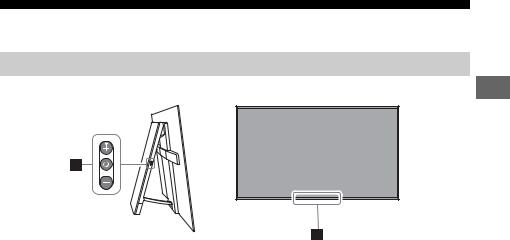
Parts and Controls
Controls and Indicators
GB
(Power) / + / –
When the TV is off,
Press to power on.
When the TV is on,
Press and hold to power off.
Press repeatedly to change the function, then press + or - button to:
•Adjust the volume.
•Select the channel.
•Select the input source of TV.
Remote Control sensor* /
Light sensor* / Illumination LED
The illumination LED lights up or blinks according to the status of the TV.
For more information, refer to the Help Guide.
* Do not place anything near the sensor.
7GB
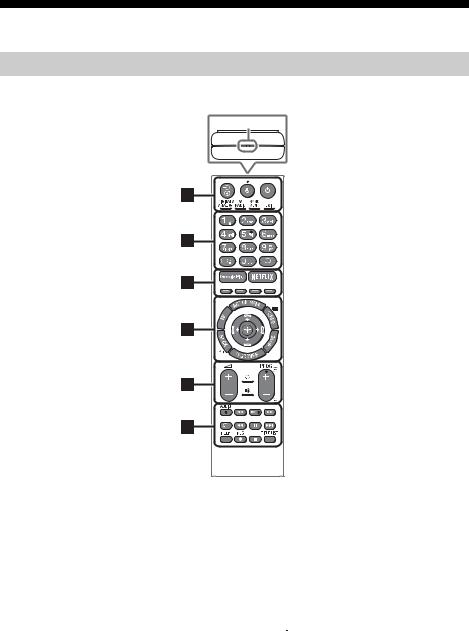
Using Remote Control
Remote Control Parts Description
The remote control shape, location, availability and function of remote control button may vary depending on your region/country/TV model.
MIC
/ (Input select/Text hold)
(Input select/Text hold)
In TV mode: Display and select the input source.
In Text mode: Hold the current page.
 (Microphone)
(Microphone)
Use Voice Function. (e.g., Search various content by voice.)
(TV standby)
Turn on or turn off the TV (standby mode).
DIGITAL/ANALOG
Switch between digital and analogue mode.
TV/RADIO
Switch between TV or RADIO broadcasts.
SYNC MENU
Display the BRAVIA Sync Menu.
EXIT
Return to the previous screen or exit from the menu. When an Interactive Application service is available, press to exit from the service.
Number buttons
 /
/ (Info/Text reveal)
(Info/Text reveal)
Display information.
(Text)
Display text information.
8GB

Google Play
Access the “Google Play” online service.
NETFLIX (Only on limited region/ country/TV model)
Access the “NETFLIX” online service.
Colour buttons
Execute corresponding function at that time.
ACTION MENU
Display a list of contextual functions.
TV
•Switch to a TV channel or input from other applications.
•Turn on the TV to display TV channel or input.
GUIDE/
Display the digital programme guide.
BACK/
Return to previous screen.
HOME
Display the TV Home Menu.
DISCOVER
Bring up the Content Bar to search for content.
/ / / /  (Item select/Enter)
(Item select/Enter)
+/– (Volume)
Adjust the volume.
 (Jump)
(Jump)
Jump back and forth between two channels or inputs. The TV alternates between the current channel or input and the last channel or input that was selected.
(Muting)
Mute the sound. Press again to restore the sound.
PROG +/–/ /
In TV mode: Select the channel.
In Text mode: Select the next ( ) or previous ( ) page.
AUDIO
Change the language for the programme currently being viewed.
/ / / / / /
Operate media contents on TV and connected BRAVIA Sync-compatible device.
GB
 (Subtitle setting)
(Subtitle setting)
Turn subtitles on or off (when the feature is available).
HELP
Display Help menu. Help Guide can be accessed from here.
REC
Record the current programme with the USB HDD recording function.
TITLE LIST
Display the Title list.
9GB
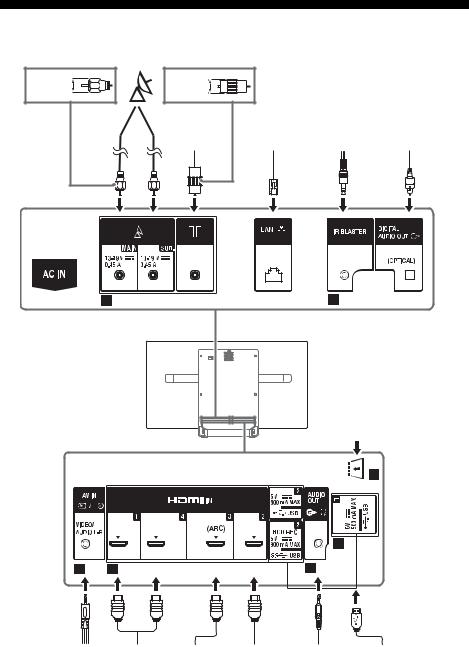
Connection Diagram
For more information on connections, refer to the Help Guide by pressing HELP on the remote control.
|
Satellite |
|
|
|
< 14 mm |
< 14 mm |
|
|
|
|
|
|
|
Home Audio |
|
|
|
|
System with |
|
Cable/Antenna/ |
|
|
Optical Audio |
|
Set Top Box |
Router |
IR Blaster |
Input |
Conditional
Access Module
VCR/Video game |
HDMI |
Home Audio |
HDMI |
Headphone/ |
Digital still camera/ |
equipment/ |
Device |
System with |
Device |
Home Audio |
Camcorder/USB |
DVD player/ |
|
ARC/HDMI |
|
System/ |
storage media |
Camcorder |
|
Device |
|
Subwoofer |
|
10GB
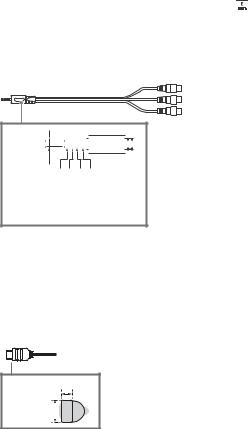
IR BLASTER*
 (Satellite input), (RF input)
(Satellite input), (RF input)
•Connections for terrestrial/cable and satellite. Connection steps: SUB. Antenna MAIN
•For SUB. jack, connect only when you are using twin tuner mode except for Single Cable Distribution EN50494.
/ AV IN
•For a composite connection, use an Analogue Extension Cable (not supplied).
•
3.5 mm 

1: L |
1 2 |
3 4 |
|
|
2:Video
3:Ground
4:R
HDMI IN 1/2/3/4
•If connecting a digital audio system that is compatible with Audio Return Channel (ARC) technology, use HDMI IN 3. If not, an additional connection with DIGITAL AUDIO OUT (OPTICAL) is necessary.
•
<12 mm
<21 mm 


AUDIO OUT  /
/
•Supports 3-pole stereo mini jack only.
•To listen to the TV's sound through the
connected equipment, press HOME. Select [Settings] [Sound] [Headphone/Audio out] and then select the desired item.


 USB 1/2,
USB 1/2,  USB 3 (HDD REC)*
USB 3 (HDD REC)*
•Connecting a large USB device may interfere with other connected devices beside it.
•When connecting a large USB device, connect to the USB 1 port.
CAM (Conditional Access Module) |
GB |
|
|
•Provides access to pay TV services. For details, refer to the instruction manual supplied with your CAM.
•Do not insert the smart card directly into the TV CAM slot. It must be fitted into the Conditional Access Module provided by your authorised dealer.
•CAM is not supported in some countries/ areas. Check with your authorised dealer.
•A CAM message may appear when you switch to a digital programme after using the Internet video.
* Only on limited region/country/TV model.
11GB
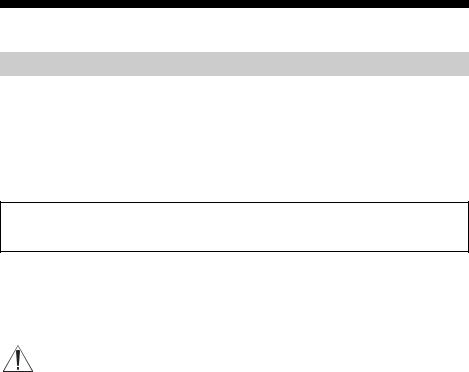
Installing the TV to the Wall
Using the optional Wall-Mount Bracket
This TV’s instruction manual only shows the steps on preparing the installation of the TV before installing to the wall.
To Customers:
For product protection and safety reasons, Sony strongly recommends that installation of your TV be performed by Sony dealers or licensed contractors. Do not attempt to install it yourself.
To Sony Dealers and Contractors:
Provide full attention to safety during the installation, periodic maintenance and examination of this product.
Sufficient expertise is required for installing this product, especially to determine the strength of the wall for withstanding the TV’s weight. Be sure to entrust the attachment of this product to the wall to Sony dealers or licensed contractors and pay adequate attention to safety during the installation. Sony is not liable for any damage or injury caused by mishandling or improper installation.
Use the Wall-Mount Bracket SU-WL450 (not supplied) to install the TV to the wall.
When installing the Wall-Mount Bracket, also refer to the Operating Instructions and Installation Guide supplied with the Wall-Mount Bracket.
Note
•Be sure to store the removed screws in a safe place, keeping them away from children.
•Be sure to hold the TV while preparing it for wall-mount installation.
For instructions on Wall-Mount Bracket installation of your TV model, refer to the following website: www.sony.eu/tv/wall-mount-bracket-manual
12GB
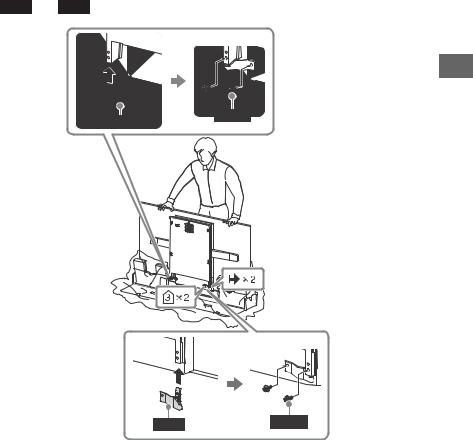
Installing the TV to the Wall from Carton
Attach WM1 and WM2 (supplied with the TV) to the rear of the TV.
GB
M4L12
WM1
WM2 |
M4L12 |
Note
• If using an electric screwdriver, set the torque at approximately 1.5 N·m {15 kgf·cm}.
13GB
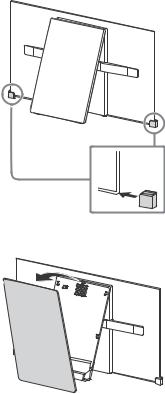
Installing the TV to the Wall from Table-Top Stand
1 Insert the corner guards.
2 Remove the center cover.
14GB
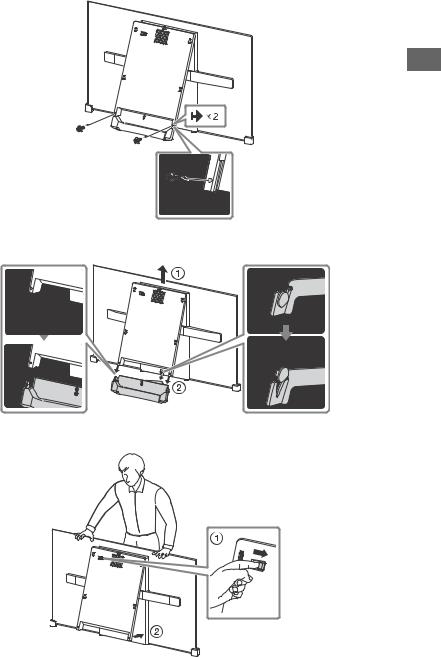
3
4
5
Remove the screws.
GB
Detach the stand base.
Close the center block by releasing the hinge lock.
15GB
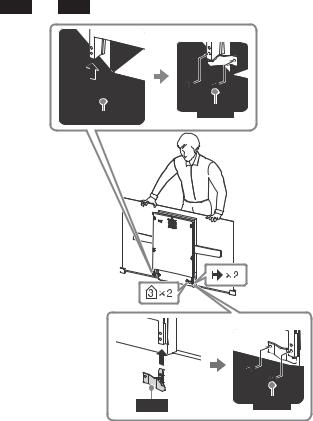
6 Attach WM1 and WM2 (supplied with the TV) to the rear of the TV.
WM1 |
M4L12 |
|
WM2 |
M4L12 |
Note
• If using an electric screwdriver, set the torque at approximately 1.5 N·m {15 kgf·cm}.
16GB

Troubleshooting
General troubleshooting for issues like: black screen, no sound, frozen picture, TV does not respond, or network is lost, do the following steps.
1Restart your TV by pressing the power button on the remote control until a message appears. The TV will restart. If the TV does not recover, try unplugging the TV from the mains lead for two minutes and then plug it in again.
2Refer to the Help menu by pressing HELP on the remote control.
3Connect your TV to the Internet and perform a software update.
4Visit Sony support website (information provided on the back cover).
When [A new TV system software update is available…] message is displayed.
Sony strongly recommends you to update the TV software by selecting [Update Now]. These software updates improve your TV performance or add new features.
The following screen with [Updating…] will appear and the illumination LED flashes white while software is updating.
Updating...
Do not unplug the mains lead during the software update. If you do, the software update may not finish completely, and it may cause a software malfunction. Software updates can take up to 15 minutes.
When you plug in TV, the TV may not be able to turn on for a while even if you press the power button on the remote control or the TV.
It takes time to initialize the system. Wait for about one minute, then operate it again.
Troubles and Solutions
When the illumination LED is flashing in red.
Count how many times it flashes (interval time is three seconds).
Reboot the TV by disconnecting the mains lead
for three minutes, then turn on the TV. |
GB |
|
If the problem persists, disconnect the mains |
||
|
||
lead, and contact your dealer or Sony service |
|
|
centre with the number of times the illumination |
|
|
LED flashes. |
|
Terrestrial/cable service cannot be received.
Check the antenna (aerial)/cable connection and booster settings.
Select terrestrial/cable service by pressing DIGITAL/ANALOG on the remote control. If the broadcasting service is not displayed, press TV and then press DIGITAL/ANALOG.
Terrestrial signal might be suppressed if there is a strong signal supplied nearby. Set [LNA (CH ---)] to [Off] in digital tuning settings.
After moving to a new house or trying to receive new services, attempt a service search by selecting [Digital Tuning].
Satellite service cannot be received.
Check the satellite cable connection.
When [No signal. LNB overload detected…] message is displayed, unplug the mains lead. Then, ensure the satellite cable is not damaged and the satellite signal line is not short-circuited in the satellite connector.
The remote control does not function.
Replace the batteries.
The parental lock for broadcast password has been forgotten.
Enter 9999 for the PIN code and select [Change PIN Code].
The TV surrounds become warm.
When the TV is used for an extended period, the TV surrounds become warm.
You may feel hot when touching there by the hand.
The screen becomes darker while watching TV.
If the whole image or part of the image remains still, the screen brightness will be gradually reduced to prevent image retention. This is not a malfunction of the TV.
17GB

You are concerned about image retention.
If the same image is displayed repeatedly or for long periods of time, image retention may occur. You can manually perform a Panel refresh to reduce image retention.
Note
•Perform Panel refresh only when image retention is particularly noticeable. As a reference, perform it only once a year. Avoid performing it more than once a year because it may affect the usable life of the panel.
•Images that include clocks, logos and bright colours (including white) easily cause image retention. Avoid displaying these types of images for long periods of time, otherwise image retention may occur.
A white line appears on the screen.
Panel refresh automatically runs after the TV has been used for long periods of time to reduce image retention. Panel refresh starts after the TV is turned off and takes about one hour to complete. A white line may be displayed on the screen during the Panel refresh. This is not a malfunction of the TV.
The message [Panel refresh did not finish…] is displayed.
Panel refresh automatically runs after the TV has been used for long periods of time to reduce image retention. If the TV is turned on, the mains lead is unplugged, or the room temperature falls outside of the range between 10 ºC and 40 ºC during the Panel refresh, the process will not be completed and this message will appear.
If Panel refresh started automatically, it will restart when you turn off the TV with the remote control.
If Panel refresh initiated manually, you must select it again.
Specifications
System
Panel system
OLED (Organic Light Emitting Diode) Panel
TV system
Depending on your country/area selection/TV model
Analogue: B/G, D/K, I
Digital: DVB-T/DVB-C
DVB-T2*
Satellite*: DVB-S/DVB-S2
Colour system
PAL, SECAM, NTSC3.58 (Video only), NTSC4.43 (Video only)
Channel coverage
Depending on your country/area selection/TV model
Analogue: UHF/VHF/Cable Digital: UHF/VHF/Cable
Satellite*: IF Frequency 950-2,150 MHz
Sound output
10 W + 10 W + 10 W + 10 W + 10 W
Wireless technology
Protocol IEEE802.11ac/a/b/g/n
(IEEE802.11ac may not be available depending on countries/regions.)
Bluetooth Version 4.1
Frequency band(s): WLAN 2.4 GHz/5 GHz, Bluetooth 2.4 GHz
Radio frequency power transmitted: 100 mW MAX
TV software version
PKG_.__.___EUA
Press HELP on the remote control to know the software version.
*Not all the TV sets have DVB-T2 or DVB-S/S2 technology or satellite antenna terminal.
Input/Output jacks
Antenna (aerial)/cable
75 ohm external terminal for VHF/UHF
Satellite antenna
Female F-Type Connector, 75 ohm.
DiSEqC 1.0, LNB 13 V/18 V & 22 kHz tone, Single Cable Distribution EN50494.
/ AV IN
Video/Audio input (mini jack)
18GB

HDMI IN 1, 2, 3, 4 (Support 4K resolution, HDCP 2.2-compatible)
Video:
4096 × 2160p (50, 60 Hz)*1*2, 4096 × 2160p (24 Hz)*1, 3840 × 2160p (50, 60 Hz)*2,
3840 × 2160p (24, 25, 30 Hz), 1080p (30, 50, 60 Hz), 1080/24p, 1080i (50, 60 Hz), 720p
(30, 50, 60 Hz), 720/24p, 576p, 576i, 480p, 480i, PC Formats
*1 3840 × 2160p is displayed when 4096 × 2160p is input.
*2 HDMI IN 2 / 3 only.
Audio: 5.1 channel linear PCM: 32, 44.1, 48, 88.2, 96, 176.4 and 192 kHz, 16, 20 and 24 bits, Dolby Digital, Dolby Digital Plus and DTS
ARC (Audio Return Channel) (HDMI IN 3 only)
(Two channel linear PCM: 48 kHz, 16 bits, Dolby Digital, Dolby Digital Plus, DTS)
 DIGITAL AUDIO OUT (OPTICAL)
DIGITAL AUDIO OUT (OPTICAL)
Digital optical jack (Two channel linear PCM: 48 kHz, 16 bits, Dolby Digital, DTS)
AUDIO OUT  / (Stereo mini jack)
/ (Stereo mini jack)
Headphone, Audio output, Subwoofer


 1,
1, 

 2,
2,  3 (HDD REC)*1
3 (HDD REC)*1
USB device port ( 3 USB HDD device for REC feature)
3 USB HDD device for REC feature)
USB port 1 and 2 support High Speed USB (USB2.0).
USB port 3 supports Super Speed USB (USB3.0).
CAM (Conditional Access Module) slot
 LAN
LAN
10BASE-T/100BASE-TX connector (Depending on the operating environment of the network, connection speed may differ. 10BASE-T/ 100BASE-TX communication rate and communication quality are not guaranteed for this TV.)
IR BLASTER *1
IR Blaster Cable input (mini jack)
Others
Optional accessories
Wall-Mount Bracket: SU-WL450
Operating temperature
0 ºC – 40 ºC
Operating humidity
10 % – 80 % RH (non-condensing)
Power, Product Fiche and others
Power requirements
Rating: Input 220 V - 240 V AC, 50 Hz
Energy Efficiency Class
KD-65A1: A |
|
|
|
||
KD-55A1: B |
|
|
|
||
Screen size (measured diagonally) (Approx.) |
GB |
||||
KD-65A1: 163.9 cm / 65 inches |
|
||||
|
|||||
KD-55A1: 138.8 cm / 55 inches |
|
||||
Power consumption |
|
||||
in [Standard] mode |
|
||||
KD-65A1: 154 W |
|
||||
KD-55A1: 135 W |
|
||||
in [Vivid] mode |
|
|
|
||
KD-65A1: 498 W |
|
||||
KD-55A1: 378 W |
|
||||
Average annual energy consumption*2 |
|
||||
KD-65A1: 214 kWh |
|
||||
KD-55A1: 187 kWh |
|
||||
Standby power consumption*3*4 |
|
||||
0.50 W (27 W in software/EPG update mode) |
|
||||
Display resolution |
|
||||
3,840 dots (horizontal) × 2,160 lines (vertical) |
|
||||
Output Rating |
|
|
|
||
USB 1/2: 5 V, |
|
|
, 500 mA MAX |
|
|
|
|
|
|||
USB 3: 5 V, |
|
, 900 mA MAX |
|
||
|
|
||||
Dimensions (Approx.) (w × h × d)
with Table-Top Stand
KD-65A1: 145.1 × 83.2 × 33.9 cm KD-55A1: 122.8 × 71.0 × 33.9 cm
without Table-Top Stand
KD-65A1: 145.1 × 83.4 × 8.6 cm KD-55A1: 122.8 × 71.1 × 8.6 cm
Mass (Approx.)
with Table-Top Stand
KD-65A1: 36.2 kg KD-55A1: 28.8 kg
without Table-Top Stand
KD-65A1: 29.8 kg KD-55A1: 25.0 kg
*1 Only on limited region/country/TV model. *2 Energy consumption per year, based on the
power consumption of the television operating 4 hours per day for 365 days. The actual energy consumption will depend on how the television is used.
*3 Specified standby power is reached after the TV finishes necessary internal processes.
*4 Standby power consumption will increase when your TV is connected to the network.
19GB
Note
•Do not remove the cover from TV CAM (Conditional Access Module) slot other than to insert a smart card fitted in CAM.
•Optional accessories availability depends on countries/region/TV model/stock.
•Design and specifications are subject to change without notice.
Notes on Digital TV function
•Digital TV (DVB terrestrial, satellite and cable), interactive services and network functions may not be available in all countries or areas. Some functions might not be enabled or might not operate correctly with some providers and network environments. Some TV service providers may charge a fee for their services.
•This TV supports digital broadcasting using MPEG-2, H.264/MPEG-4 AVC and H.265/ HEVC codecs, but compatibility with all operator/service signals, which may change over time, cannot be guaranteed.
Trademark Information
•The terms HDMI and HDMI High-Definition Multimedia Interface, and the HDMI Logo are trademarks or registered trademarks of HDMI Licensing LLC in the United States and other countries.
•Manufactured under license from Dolby Laboratories.
Dolby, Dolby Audio, and the double-D symbol are trademarks of Dolby Laboratories.
•“BRAVIA” and 


 are trademarks of Sony Corporation.
are trademarks of Sony Corporation.
•Gracenote, Gracenote eyeQ, Gracenote VideoID, Gracenote Video Explore, the Gracenote logo and logotype, and the “Powered by Gracenote” logo are either registered trademarks or trademarks of Gracenote in the United States and/or other countries.
•Opera® Devices SDK. Copyright 1995-2016 Opera TV AS. All rights reserved.
•Wi-Fi, Wi-Fi Direct, Miracast, Wi-Fi Protected Setup and Wi-Fi CERTIFIED Logo are trademarks or registered trademarks of Wi-Fi Alliance.
•For DTS patents, see http://patents.dts.com. Manufactured under license from DTS, Inc.
DTS, the Symbol, & DTS and the Symbol together are registered trademarks, and DTS Digital Surround is a trademark of DTS, Inc. © DTS, Inc. All Rights Reserved.
•The Bluetooth® word mark and logos are registered trademarks owned by the Bluetooth SIG, Inc. and any use of such marks by Sony Corporation is under license. Other trademarks and trade names are those of their respective owners.
•DiSEqC™ is a trademark of EUTELSAT. This TV supports DiSEqC 1.0. This TV is not intended for controlling motorized antennas.
•TUXERA is a registered trademark of Tuxera Inc. in the US and other countries.
•USB-IF SuperSpeed USB Trident logo is a
registered trademark of USB Implementers Forum, Inc. 
20GB
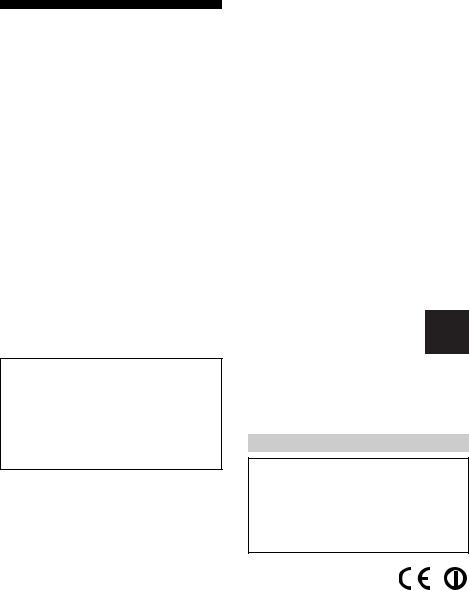
Table des matières
AVIS IMPORTANT. . . . . . . . . . . . . . . . . . . . . . . 2 Consignes de sécurité . . . . . . . . . . . . . . . . . . 3 Précautions . . . . . . . . . . . . . . . . . . . . . . . . . . . 5 Protection de l’écran du téléviseur (Téléviseur OLED) . . . . . . . . . . . . . . . . . . . . . . 7
Pièces et commandes . . . . . . . . . . . . . . . . 8
Commandes et voyants . . . . . . . . . . . . . . . . .8
Utilisation de la télécommande . . . . . . . . 9
Description des pièces de la
télécommande . . . . . . . . . . . . . . . . . . . . . . . .9
Schéma de connexion . . . . . . . . . . . . . . . .11 Installation du téléviseur au mur . . . . . . 13
Utilisation du support de fixation
murale en option . . . . . . . . . . . . . . . . . . . . . 13
Dépannage . . . . . . . . . . . . . . . . . . . . . . . . 18
Problèmes et solutions . . . . . . . . . . . . . . . . 18
Spécifications . . . . . . . . . . . . . . . . . . . . . . 20
Connexion Internet et confidentialité des données
Ce produit se connecte à Internet au cours de la configuration initiale dès qu’un réseau est connecté afin de confirmer la connexion Internet, puis ultérieurement pour configurer l’écran d’accueil. Votre adresse IP est utilisée dans ces connexions Internet et toutes les autres. Si vous ne voulez pas que votre adresse IP soit utilisée, ne configurez pas la fonction Internet sans fil et ne connectez pas de câble Internet. Veuillez vous référer aux informations de confidentialité présentées dans les écrans de configuration pour en savoir plus sur les connexions Internet.
Introduction
Sony vous remercie d’avoir choisi ce téléviseur.
Avant de l’utiliser, nous vous invitons à lire attentivement ce manuel et à le conserver pour vous y référer ultérieurement.
Remarque
•Avant d’utiliser le téléviseur, lisez les « Consignes de sécurité » (page 3).
•Les images et illustrations reprises dans ce manuel et dans le Guide d’installation sont fournies pour référence uniquement et peuvent présenter des différences par rapport au produit proprement dit.
Emplacement du Guide d’installation
Le Guide d’installation est placé au-dessus du rembourrage à l’intérieur du carton du téléviseur.
Aide/Guide d’aide
La fonction Aide contient un grand nombre d’informations concernant votre téléviseur. Pour utiliser la fonction Aide, appuyez sur la touche HELP de la télécommande. Vous trouverez des solutions et le dépannage dans la liste ou la recherche par mot-clé. Sélectionnez [Guide d’aide] dans le menu Aide pour afficher le manuel. Si vous connectez votre téléviseur à Internet, la fonction Aide et les informations qu’elle contient seront mises à jour.
Emplacement de l’étiquette d’identification
Les étiquettes reprenant le numéro de modèle, la date de production (année/mois) et les caractéristiques nominales de l’alimentation se trouvent à l’arrière du téléviseur ou de l’emballage. Vous les trouverez en retirant le couvercle central.
AVERTISSEMENT
POUR ÉVITER LES
INCENDIES, TENEZ  TOUJOURS LES BOUGIES ET AUTRES FLAMMES NUES ÉLOIGNÉES DE CE PRODUIT.
TOUJOURS LES BOUGIES ET AUTRES FLAMMES NUES ÉLOIGNÉES DE CE PRODUIT.
AVIS IMPORTANT
Ce produit a été fabriqué par ou pour le compte de Sony Corporation, 1-7-1 Konan Minato-ku Tokyo, 108-0075 Japon. Toutes les questions relatives à la conformité des produits basées sur la législation européenne doivent être adressées à son représentant, Sony Belgium, bijkantoor van Sony Europe Limited, Da Vincilaan 7-D1, 1935 Zaventem, Belgique. Pour toute question relative au Service Après-Vente ou à la Garantie, merci de bien vouloir vous référer aux coordonnées qui vous sont communiquées dans les documents « Service (SAV) » ou Garantie.
Avis concernant les équipements radio
Par les présentes, Sony Corporation
déclare que les équipements radio type KD-65A1, KD-55A1 sont conformes aux exigences essentielles et aux autres dispositions pertinentes de la directive 1999/5/CE. Pour toute information complémentaire, veuillez consulter l’URL suivante : http://www.compliance.sony.de/
Cet équipement radio peut être utilisé dans l’UE sans enfreindre les exigences en vigueur relatives à l’utilisation du spectre radio.
Avis aux clients : les informations suivantes s’appliquent uniquement aux appareils vendus dans les pays qui appliquent les directives de l’UE.
2FR

Le système de télévision sans fil peut être utilisé dans les pays suivants :
AT, BE, HR, CY, CZ, DK, EE, FI, FR, DE, EL, HU, IE, IT, LV, LT, LU, MT, NL, PL, PT, SK, SI, ES, SE, UK, IS, LI, NO, CH, BG, RO, TR, AL, BA, MK, MD, RS, ME, Kosovo
Cet appareil peut être utilisé dans d’autres pays non européens.
Consignes de sécurité
AVERTISSEMENT
Les piles ne doivent pas être exposées à une chaleur excessive, par exemple rayon du soleil, feu ou toute source de chaleur similaire.
Ne placez jamais un téléviseur dans un endroit instable. Un téléviseur peut tomber et occasionner de graves blessures corporelles, voire la mort. De nombreuses blessures, notamment chez les enfants, peuvent être évitées en prenant de simples précautions telles que :
Utiliser les meubles ou les supports recommandés par le fabricant du téléviseur.
N’utiliser que des meubles capables de supporter le téléviseur en toute sécurité.
S’assurer que le téléviseur ne dépasse pas du bord du meuble qui le supporte.
Ne pas placer le téléviseur sur un meuble haut (par exemple, armoires ou bibliothèques) sans ancrer à la fois le meuble et le téléviseur à un support adapté.
Ne pas placer le téléviseur sur du tissu ou autre matériau placé entre le téléviseur et le meuble de support.
Apprendre aux enfants qu’il est dangereux de monter sur le
meuble pour atteindre le téléviseur ou ses touches de commande.
Si vous conservez et déménagez votre téléviseur existant, les points ci-dessus doivent également être pris en compte et appliqués.
Installation/Mise en place
L’installation du téléviseur sur le support de table exige un certain savoir-faire.
Reportez-vous au Guide d’installation fourni avec le téléviseur pour l’installation du support.
Sony n’est responsable d’aucun dégât ou blessure provoqué par une erreur de manipulation ou installation incorrecte.
Installez et utilisez le téléviseur conformément aux instructions ci-dessous afin d’éviter tout risque d’incendie, d’électrocution ou autre dommage et/ou blessure.
Installation
•Le téléviseur doit être installé à proximité d’une prise de courant aisément accessible.
•Positionnez le téléviseur sur une surface stable et horizontale afin d'éviter qu'il ne tombe, n'entraîne des blessures ou n'endommage des biens.
•Installez le téléviseur dans un endroit où vous ne risquez pas de le pousser, de le tirer ou de le renverser.
•Installez le téléviseur de façon à ce que sa base ne dépasse pas du meuble TV (non fourni). Si la base du téléviseur dépasse du meuble TV, le téléviseur risque d’être renversé, de tomber, d’être endommagé ou de provoquer des blessures.
FR
•L’installation murale du téléviseur doit être confiée à un technicien spécialisé.
•Pour des raisons de sécurité, il est vivement recommandé
d’utiliser les accessoires Sony, notamment :Support de fixation murale SU-WL450
•Veillez à bien utiliser les vis fournies avec le support de fixation murale lors de la mise en place du support de fixation murale sur le téléviseur. Les vis fournies sont conçues de la manière illustrée, mesurées à partir de la surface de fixation du support de fixation murale.
Leur diamètre et leur longueur varient suivant le modèle de support de fixation murale.
L’utilisation de vis autres que celles fournies peut occasionner des dégâts à l’intérieur du téléviseur ou provoquer sa chute, etc.
10 mm - 14 mm
Vis (M6) |
Support de fixation murale |
Cache arrière du téléviseur
Transport
•Avant de transporter le téléviseur, débranchez tous ses câbles.
•La présence de deux ou trois personnes est nécessaire pour le transport des téléviseurs de grande taille.
•Pour transporter le téléviseur à la main, saisissez-le de la manière illustrée. N’exercez aucune pression sur le panneau et le cadre qui l’entoure.
•Lors de la manipulation ou du montage du téléviseur, ne couchez pas le téléviseur.
•Lorsque vous transportez le
téléviseur, ne le soumettez pas à des secousses ou des vibrations excessives.
3FR
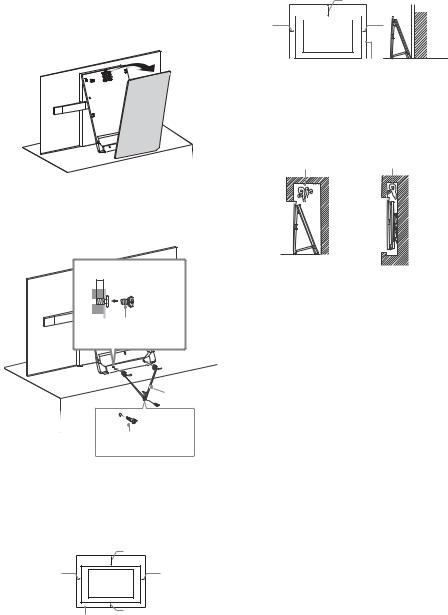
•Lorsque vous transportez le téléviseur pour le porter à réparer ou lorsque vous déménagez, glissez-le dans son emballage et son carton d’origine.
Prévention des basculements
1 Retirez le couvercle central.
2 Fixez le téléviseur au support TV.
10 mm - 14 mm
Vis M6
(non fournie)
Cordon |
(non fourni) |
Vis (non fournie)
Aération
•Vous ne devez jamais obstruer les orifices d’aération du boîtier ni y introduire un objet quelconque.
•Laissez un espace libre autour du téléviseur, comme indiqué ci-dessous.
•Il est vivement recommandé d’utiliser le support de fixation murale Sony pour favoriser la circulation adéquate de l’air.
Installation murale
|
30 cm |
10 cm |
10 cm |
|
|
|
10 cm |
Laissez au moins cet espace libre autour du téléviseur.
Installation sur pied
30 cm

 1 cm
1 cm
10 cm |
|
|
|
10 cm |
Mur
Laissez au moins cet espace libre autour du téléviseur.
•Pour une ventilation correcte, sans accumulation de salissures ni de poussière :
Ne placez pas le téléviseur à plat, à l’envers, vers l’arrière ou sur le côté.
Ne placez pas le téléviseur sur une étagère, un tapis, un lit ou dans un placard.
Ne couvrez pas le téléviseur avec des tissus tels que des rideaux, pas plus qu’avec des journaux, etc.
N’installez pas le téléviseur comme illustré ci-dessous.
La circulation de l’air est bloquée.
Mur |
Mur |
Cordon d’alimentation secteur
Manipulez le cordon et la prise d’alimentation secteur comme indiqué ci-dessous afin d’éviter tout risque d’incendie, d’électrocution ou autre dommage et/ou blessure :
Utilisez uniquement un cordon d’alimentation Sony et pas d’une autre marque.
Insérez la fiche à fond dans la prise secteur.
Utilisez le téléviseur sur une alimentation de 220 V - 240 V CA uniquement.
Pour votre propre sécurité, assurez-vous que le cordon d’alimentation secteur est débranché lorsque vous réalisez des branchements et veillez à ne pas trébucher dans les câbles.
Avant d’effectuer tout type d’intervention ou de déplacer le téléviseur, débranchez le cordon d’alimentation secteur de la prise de courant.
Eloignez le cordon d’alimentation secteur des sources de chaleur.
Débranchez la fiche du cordon d’alimentation secteur et nettoyez-la régulièrement. Si la fiche accumule de la poussière ou est exposée à l’humidité, son isolation peut se détériorer et un incendie peut se déclarer.
Remarque
•N’utilisez pas le cordon d’alimentation fourni avec un autre appareil.
•Ne pliez pas et ne tordez pas exagérément le cordon d’alimentation secteur. Cela pourrait mettre à nu ou rompre les fils conducteurs.
•Ne modifiez pas le cordon d’alimentation secteur.
•Ne posez jamais d’objet lourd sur le cordon d’alimentation secteur.
•Ne tirez jamais sur le cordon d’alimentation secteur proprement dit pour le débrancher.
•Veillez à ne pas brancher un trop grand nombre d’appareils sur la même prise de courant.
•Pour la prise de courant, n’utilisez pas une prise de mauvaise qualité.
4FR
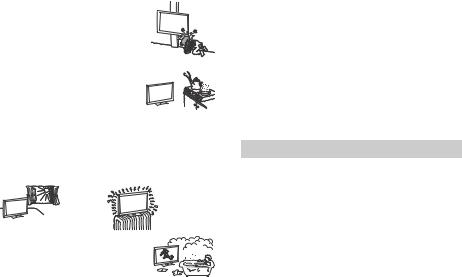
Ce qu’il ne faut pas faire
N’installez/n’utilisez pas le téléviseur dans des lieux, environnements ou situations comparables à ceux répertoriés ci-dessous car sinon, il risque de ne pas fonctionner correctement ou de provoquer un incendie, une électrocution, d’autres dommages et/ou des blessures.
Lieu :
•A l’extérieur (en plein soleil), au bord de la mer, sur un bateau ou voilier, à l’intérieur d’un véhicule, dans des établissements hospitaliers, des sites instables, exposés à la pluie, l’humidité ou à la fumée.
Environnement :
•Endroits excessivement chauds, humides ou poussiéreux ; accessibles aux insectes ; soumis à des vibrations mécaniques, à proximité d’objets inflammables (bougies, etc.). Le téléviseur ne doit être exposé à aucune forme d’écoulement ou d’éclaboussure. C’est pourquoi aucun objet rempli d’un liquide quelconque, comme un vase, ne doit être placé sur le téléviseur.
Situation :
•À utiliser lorsque vos mains sont mouillées, en l’absence de boîtier, ou avec des accessoires non recommandés par le fabricant. En cas d’orage, débranchez le téléviseur de la prise secteur et de la prise d’antenne.
•Installer le téléviseur de manière saillante dans un espace ouvert. Des personnes
pourraient se blesser ou l’endommager ou des objets pourraient se heurter au téléviseur.
• Placer le téléviseur dans un endroit humide ou poussiéreux, ou dans une pièce pleine de vapeur ou de fumée grasse (près des tables de cuisson ou d’humidificateurs). Il pourrait en résulter un incendie, des risques d’électrocution ou des déformations.
•Installer le téléviseur à des endroits soumis à des températures extrêmes, par exemple à la lumière directe du soleil, ou près d’un radiateur ou d’un ventilateur soufflant de l’air chaud. Il peut en résulter une surchauffe du téléviseur, susceptible de déformer le boîtier et/ou d’entraîner le dysfonctionnement du téléviseur.
• Si le téléviseur est placé dans les vestiaires de thermes ou de bains publics, le soufre dans l’atmosphère, etc., risque de l’endommager.
•Pour une qualité d’image optimale, n’exposez pas l’écran à un éclairage direct ou aux rayons directs du soleil.
•Évitez de déplacer le téléviseur d’une zone à une zone chaude. Les changements brusques de température ambiante peuvent entraîner une condensation de l’humidité. Le téléviseur peut alors diffuser des images et/ou des couleurs de qualité médiocre. Dans une telle éventualité, laissez l’humidité s’évaporer complètement avant de mettre le téléviseur sous tension.
Eclats et projections d’objets :
•Ne projetez aucun objet en direction du téléviseur. Le verre de l’écran pourrait être brisé lors de l’impact et provoquer des blessures graves.
•Si la surface de l’écran se fendille, ne touchez pas le téléviseur avant d’avoir débranché le cordon d’alimentation secteur. Sinon, cela pourrait entraîner un risque d’électrocution.
Au repos
•Si vous envisagez de ne pas utiliser le téléviseur pendant plusieurs jours, il est conseillé de le débrancher de l’alimentation secteur pour des raisons de sécurité et de protection de l’environnement.
•Le téléviseur étant toujours sous tension lorsqu’il est simplement éteint, débranchez la fiche d’alimentation secteur de la prise de courant pour le mettre complètement hors tension.
•Certains téléviseurs possèdent des caractéristiques dont le bon fonctionnement peut exiger que l’appareil demeure sous tension lorsqu’il est en mode veille.
Avec les enfants |
FR |
|
|
•Ne laissez pas les enfants grimper sur le téléviseur.
•Conservez les petits accessoires hors de portée des enfants pour éviter tout risque d’ingestion accidentelle.
Si vous rencontrez les problèmes suivants...
Eteignez le téléviseur et débranchez immédiatement le cordon d’alimentation de la prise secteur si l’un des problèmes suivants devait survenir.
Contactez votre revendeur ou le centre de service après-vente Sony pour faire contrôler votre téléviseur par un technicien spécialisé.
Si :
Le cordon d’alimentation secteur est endommagé.
La prise de courant est de mauvaise qualité.
Le téléviseur est endommagé après avoir subi une chute, un impact ou la projection d’un objet.
Un objet liquide ou solide a pénétré à l’intérieur des ouvertures du boîtier.
À propos de la température du téléviseur
Si vous utilisez le téléviseur pendant une période prolongée, la température augmente dans la zone entourant le panneau.
Si vous le touchez, vous remarquerez peut-être qu’il est chaud.
Précautions
Regarder la télévision
•Regarder la télévision dans une pièce modérément éclairée ou peu éclairée ou pendant une période prolongée soumet vos yeux à un effort.
•Si vous utilisez un casque, réglez le volume de façon à éviter un niveau sonore excessif qui pourrait altérer votre capacité auditive.
Ecran OLED
•Bien que l’écran OLED soit fabriqué avec une technologie de haute précision et soit doté d’une définition de pixels effectifs de 99,99 % ou supérieure, il est possible que quelques points noirs ou points lumineux (blancs, rouges, bleus ou verts) apparaissent constamment sur l’écran OLED. Ce phénomène est inhérent à la structure de l’écran OLED et n’indique pas un dysfonctionnement.
•N’appuyez pas sur le filtre avant, ne l’éraflez pas et ne placez pas d’objets sur ce téléviseur. L’image pourrait être instable ou l’écran OLED être endommagé.
•L’écran et le boîtier se réchauffent lorsque le téléviseur est en cours d’utilisation. Ceci n’a rien d’anormal.
•Lors de la mise au rebut de votre téléviseur, assurezvous de res pecter les lois et les réglementations locales.
5FR
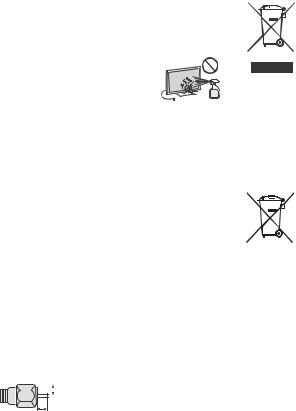
Traitement et nettoyage du boîtier et de la surface de l’écran du téléviseur
Assurez-vous que le cordon d’alimentation secteur relié au téléviseur est débranché de la prise de courant avant d’entreprendre toute opération de nettoyage.
Pour éviter toute dégradation du matériau ou du revêtement de l’écran, respectez les précautions suivantes.
•Pour ôter la poussière du boîtier ou de la surface de l’écran, frottez délicatement avec un linge doux. En cas de saleté tenace, frottez avec un linge doux légèrement imprégné d’une solution à base de détergent doux dilué.
•Ne jamais vaporiser d’eau ou de détergent directement sur le téléviseur. Le liquide
pourrait couler au bas de l’écran ou sur les parties extérieures, voire pénétrer dans le téléviseur et l’endommager.
•N’utilisez jamais d’éponge abrasive, de produit de nettoyage alcalin/acide, de
poudre à récurer ou de solvant volatil, qu’il s’agisse d’alcool, d’essence, de diluant ou d’insecticide. L’utilisation de ces produits ou tout contact prolongé avec des matériaux en caoutchouc ou en vinyle peut endommager la surface de l’écran et le matériau du boîtier.
•Ne touchez pas le téléviseur si votre main est recouverte d'une substance chimique quelconque, comme de la crème pour les mains ou de l'écran total.
•Le nettoyage régulier des ouvertures de ventilation est recommandé pour assurer une ventilation correcte.
•Si l’angle du téléviseur doit être réglé, déplacez lentement ce dernier pour éviter qu’il ne se désolidarise et tombe de son pied.
Appareils optionnels
•Éloignez le téléviseur de tout appareil ou équipement optionnel émettant des rayonnements électromagnétiques. Sinon, cela pourrait entraîner une déformation de l’image et/ou un bruit.
•Cet appareil a été testé et déclaré conforme aux limites de la Directive CEM lors de l’utilisation d’un câble de signal de liaison dont la longueur ne dépasse pas 3 mètres.
•Cet appareil a été testé et déclaré conforme aux limites de la Directive CEM lors de l’utilisation d’un câble RF dont la longueur ne dépasse pas 30 mètres pour la borne terrestre/satellite/ télévision par câble.
Recommandation relative à la fiche de type F
Le fil interne ne peut pas dépasser le connecteur de plus de 1,5 mm.

 7 mm max.
7 mm max.
1,5 mm max.
(Illustration de référence de la fiche de type F)
Fonction sans fil de l’appareil
•N’utilisez pas cet appareil à proximité d’un équipement médical (stimulateur cardiaque, par exemple), car cela pourrait altérer le bon fonctionnement de ce dernier.
•Même si cet appareil émet/reçoit des signaux brouillés, soyez attentif aux éventuelles interceptions non autorisées. Nous ne pouvons être tenus responsables de tout problème que cela pourrait entraîner.
•Cet équipement doit être installé et utilisé en laissant une distance de séparation d’au moins 20 cm entre l’antenne de ce périphérique et le corps d’une personne.
Faire attention lors de l’utilisation de la télécommande
•Respectez les polarités lors de l’insertion de piles.
•Ne mélangez pas des piles de types différents, ni des piles usagées avec des piles neuves.
•Respectez l’environnement lorsque vous jetez les piles. L’élimination des piles peut être réglementée dans certaines régions. Consultez les autorités locales.
•Manipulez la télécommande avec soin. Ne la laissez pas tomber, ne la piétinez pas et ne renversez aucun liquide sur celle-ci.
•Ne placez pas la télécommande à proximité d’une source de chaleur, dans un endroit exposé à la lumière directe du soleil ou dans une pièce humide.
Mise au rebut du téléviseur
Traitement des appareils électriques et électroniques en fin de vie (Applicable dans les pays de l’Union Européenne et aux autres pays européens disposant de systèmes de collecte sélective)
Ce symbole, apposé sur le produit ou sur son emballage, indique que ce produit ne doit pas
être traité avec les déchets ménagers. Il doit être remis à un point de collecte approprié pour le recyclage des équipements électriques et électroniques. En vous assurant que ce produit sont mis au rebut de façon appropriée, vous participez activement à la prévention des conséquences négatives que leur mauvais traitement pourrait provoquer sur l’environnement et sur la santé humaine. Le recyclage des matériaux contribue par ailleurs à la préservation des ressources naturelles. Pour toute information complémentaire au sujet du recyclage de ce produit, vous pouvez contacter votre municipalité, votre déchetterie locale ou le point de vente où vous avez acheté le produit.
Elimination des piles et accumulateurs usagés (Applicable dans les pays de l’Union Européenne et aux autres pays européens disposant de systèmes de collecte sélective)
Ce symbole, apposé sur les piles et accumulateurs ou sur les emballages, indique que les piles et accumulateurs fournis avec ce produit ne doivent pas être traités comme de simples déchets ménagers. Sur certains types de piles, ce symbole apparaît parfois combiné avec un symbole chimique. Les symboles pour le mercure (Hg) ou le plomb (Pb) sont rajoutés lorsque ces piles contiennent plus de 0,0005 % de mercure ou 0,004 % de plomb. En vous assurant que ces piles et accumulateurs sont mis au rebut de façon appropriée, vous participez activement à la prévention des conséquences négatives que leur mauvais traitement pourrait provoquer sur l’environnement et sur la santé humaine. Le recyclage des matériaux contribue par ailleurs à la préservation des ressources naturelles. Pour les produits qui pour des raisons de sécurité, de performance ou d’intégrité de données nécessitent une connexion permanente à une pile ou à un accumulateur, il conviendra de vous rapprocher d’un service technique qualifié pour effectuer son remplacement. En rapportant votre appareil électrique en fin de vie à un point de collecte approprié vous vous assurez que la pile ou l’accumulateur incorporé sera traité correctement. Pour tous les autres cas de figure et afin d’enlever les piles ou accumulateurs en toute sécurité de votre appareil, reportez-vous au manuel d’utilisation. Rapportez les piles ou accumulateurs usagés au point de collecte approprié pour le recyclage. Pour toute information complémentaire au sujet du recyclage de ce produit ou des piles et accumulateurs, vous pouvez contacter votre municipalité, votre déchetterie locale ou le point de vente où vous avez acheté ce produit.
6FR

Protection de l’écran du téléviseur (Téléviseur OLED)
Précautions à prendre pour protéger l’écran des dommages
Rémanence d’image
Les téléviseurs OLED sont sensibles à la rémanence d’image en raison des caractéristiques des matériaux utilisés. La rémanence d’image peut survenir si des images s’affichent plusieurs fois au même emplacement sur l’écran ou pendant des périodes prolongées. Il ne s’agit pas d’un dysfonctionnement du téléviseur. Évitez d’afficher des images pouvant causer une rémanence d’image.
FR
Voici des exemples d’images pouvant causer une rémanence d’image :
•Contenu avec des bandes noires en haut et en bas et/ou sur la gauche et la droite de l’écran. (ex : écran 4:3 « letterboxé », définition Standard)
•Images statiques, comme des photos.
•Jeux vidéo pouvant avoir un contenu statique sur une partie de l’écran.
•Menus à l’écran, guides des programmes, logos des chaînes, etc.
•Contenu statique des applications.
•Téléscripteurs à l’écran, comme ceux utilisés dans les journaux télévisés et les titres.
Pour réduire le risque de rémanence d’image :
•Remplissez l’écran en modifiant [Mode Large] pour éliminer les bandes noires. Sélectionnez un [Mode Large] autre que [Normal].
•Désactivez l’OSD (affichage sur écran) en appuyant sur le bouton  /
/ puis désactivez les menus de l’appareil raccordé. Pour plus de détails, reportez-vous au mode d’emploi de l’appareil raccordé.
puis désactivez les menus de l’appareil raccordé. Pour plus de détails, reportez-vous au mode d’emploi de l’appareil raccordé.
•Évitez d’afficher des images statiques aux couleurs vives (y compris du blanc), des horloges ou des logos sur une partie de l’écran.
•Configurez les réglages de l’image en fonction des conditions ambiantes. L’image Standard est recommandée pour un usage domestique et lors de la visualisation d’un contenu affichant souvent les logos de la station, etc.
Le téléviseur possède les fonctionnalités suivantes pour aider à réduire/empêcher la rémanence d’image.
Actualisation du panneau
L’actualisation du panneau s’exécute automatiquement pour ajuster l’uniformité de l’écran du téléviseur après qu’il a été utilisé pendant de longues périodes. L’actualisation du panneau peut également être effectuée manuellement et ne doit être utilisée que si la rémanence d’image est très visible ou si vous voyez le message suivant : [L'actualisation du panneau ne s'est pas terminée…]
Attention :
•La fonction Actualisation du panneau peut affecter le panneau. En guise de référence, effectuez l’actualisation du panneau une seule fois par an et pas plus, car elle peut réduire la durée de vie du panneau.
•L’actualisation du panneau dure environ une heure.
•Une ligne blanche peut s’afficher sur l’écran lors de l’actualisation du panneau ; il ne s’agit pas d’un dysfonctionnement du téléviseur.
•L’actualisation du panneau ne fonctionne que lorsque la température ambiante est comprise entre 10 ºC et 40 ºC.
Décalage des pixels
Place automatiquement l’image sur l’écran pour empêcher la rémanence d’image.
Autre fonctionnalité
La luminosité de l’écran est automatiquement réduite lors de l’affichage d’images fixes, d’horloges, de couleurs vives ou de logos, etc.
7FR
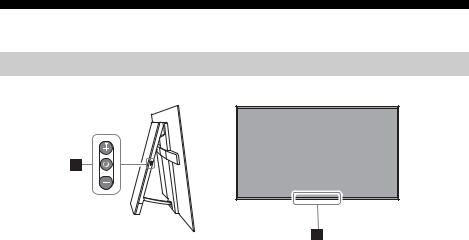
Pièces et commandes
Commandes et voyants
(Alimentation) / + / –
Lorsque le téléviseur est éteint,
Appuyez sur pour l’allumer.
Lorsque le téléviseur est allumé,
Maintenir la touche enfoncée pour éteindre.
Appuyez sur plusieurs fois pour changer de fonction, puis appuyez sur la touche + ou
– pour :
•Réglage du volume.
•Choix du canal.
•Sélection de la source d’entrée du téléviseur.
Capteur de télécommande* / Capteur de lumière* / Affichage LED
L’affichage LED s’allume ou clignote selon l’état du téléviseur.
Pour plus d’informations, consultez le Guide d’aide.
* Ne posez aucun objet à proximité du capteur.
8FR
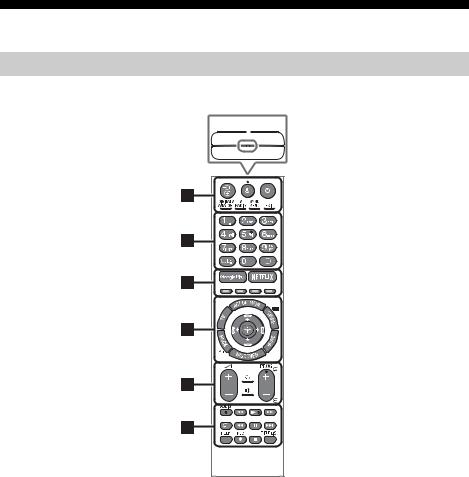
Utilisation de la télécommande
Description des pièces de la télécommande
La forme de la télécommande, l’emplacement, la disponibilité et la fonction des touches de la télécommande peuvent varier selon votre région/pays/modèle de téléviseur.
MIC |
FR |
|
|
|
|
|
|
|
/ (Sélection de l’entrée/Maintien du Télétexte)
(Sélection de l’entrée/Maintien du Télétexte)
En mode TV : Pour afficher et sélectionner la source d’entrée.
En mode Télétexte : Maintenez la page en cours.
 (Microphone)
(Microphone)
Pour utiliser la fonction vocale. (Par exemple, pour rechercher du contenu à l’aide de la voix.)
(Veille du téléviseur)
Pour mettre le téléviseur sous ou hors tension (mode veille).
DIGITAL/ANALOG
Passez du mode numérique au mode analogique et vice versa.
TV/RADIO
Passez de la diffusion TV à la diffusion RADIO et vice versa.
SYNC MENU
Affichez le menu BRAVIA Sync.
EXIT
Revenez à l’écran précédent ou quittez le menu. Quand un service d’application interactive est disponible, appuyez sur cette touche pour quitter le service.
9FR

Touches numériques
 /
/ (Affichage des infos/du Télétexte)
(Affichage des infos/du Télétexte)
Affichez des informations.
(Télétexte)
Affichez les informations de Télétexte.
Google Play
Accédez au service en ligne « Google Play ».
NETFLIX (Uniquement pour certaines régions, certains pays ou certains modèles de téléviseur)
Accédez au service en ligne « NETFLIX ».
Touches de couleur
Exécutez la fonction correspondante à ce moment.
ACTION MENU
Pour afficher la liste des fonctions contextuelles.
TV
•Commutez sur une chaîne télévisée ou une entrée provenant d’autres applications.
•Allumez le téléviseur pour afficher l’entrée ou la chaîne télévisée.
GUIDE/
Affichez le guide des programmes numériques.
BACK/
Revenez à l’écran précédent.
HOME
Affichez le menu Accueil du téléviseur.
DISCOVER
Affichez la barre de contenu pour rechercher du contenu.
/ / / /  (Sélection/validation des options)
(Sélection/validation des options)
+/– (Volume)
Réglez le volume.
 (Saut)
(Saut)
Basculez entre deux chaînes ou entrées. Le téléviseur affiche successivement la chaîne ou l’entrée en cours et la dernière chaîne ou entrée sélectionnée.
(Coupure du son)
Coupez le son. Appuyez à nouveau sur la touche pour rétablir le son.
PROG +/–/ /
En mode TV : Sélectionnez la chaîne.
En mode Télétexte : Sélectionnez la page suivante ( ) ou précédente ( ).
AUDIO
Modifiez la langue du programme en cours de visionnage.
/ / / / / /
Utilisez du contenu multimédia sur le téléviseur et le périphérique compatible BRAVIA Sync raccordé.
 (Réglage sous-titre)
(Réglage sous-titre)
Activez ou désactivez les sous-titres (lorsque cette fonction est disponible).
HELP
Affichez le menu Aide. Le Guide d'aide est accessible à partir de là.
REC
Enregistrez le programme en cours à l’aide de la fonction d’enregistrement sur USB HDD.
TITLE LIST
Affichez la liste des titres.
10FR
